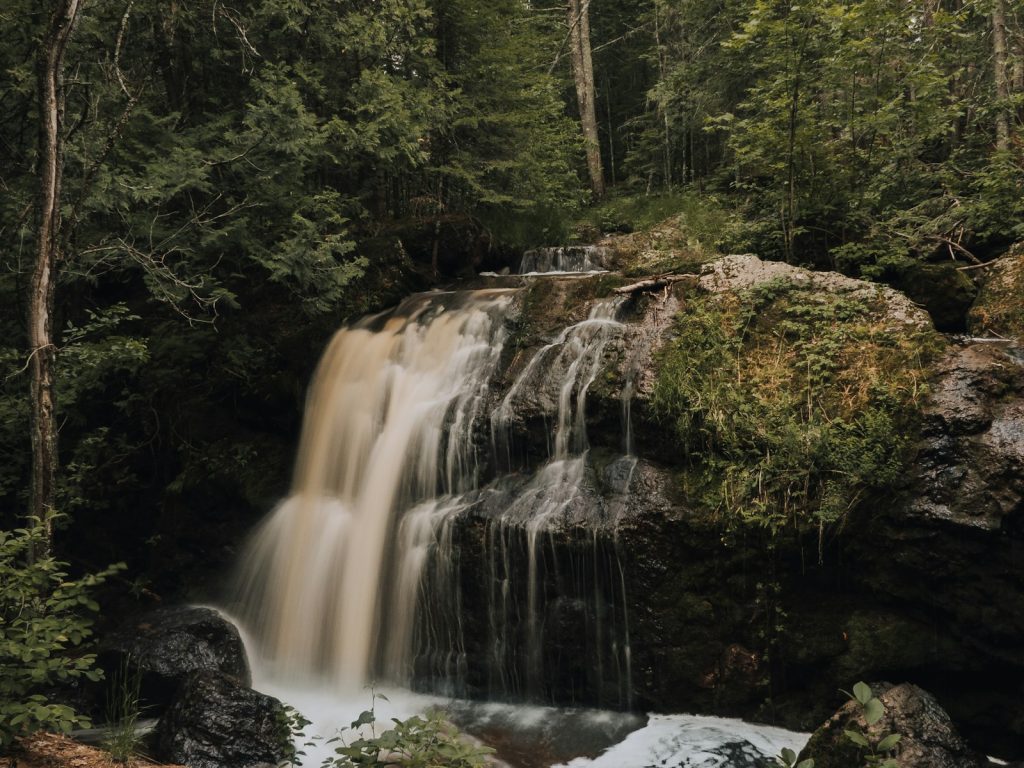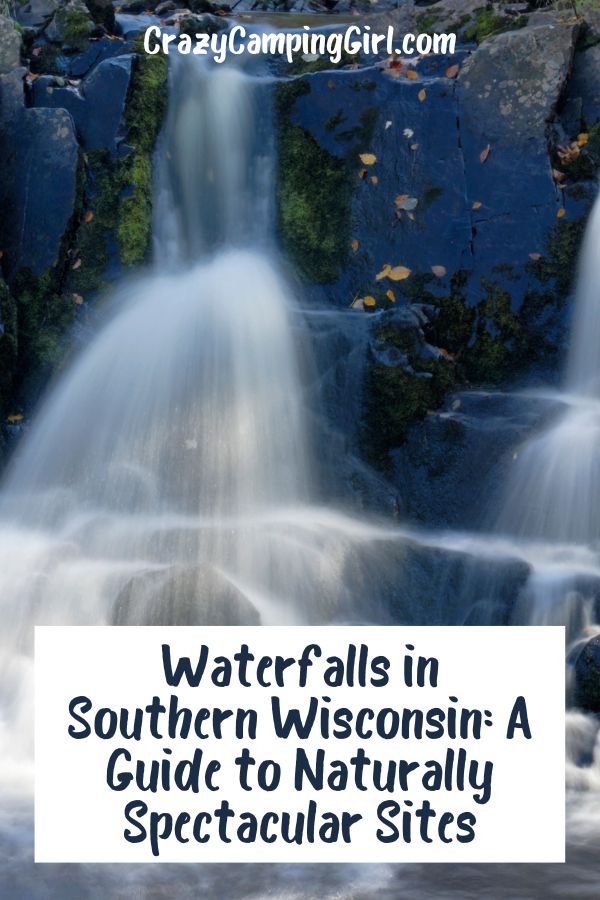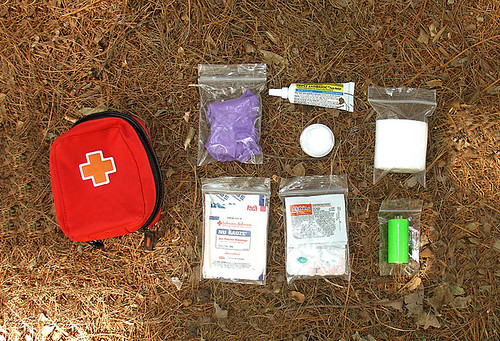
Waterfalls in Southern Wisconsin: A Guide to Naturally Spectacular Sites
We may earn money or products from the companies mentioned in this post.
While Southern Wisconsin is known more for its rolling hills and agricultural landscapes, it still offers a sprinkle of natural wonders, particularly its waterfalls. Waterfalls in this region may not be as grandiose as those found in the northern parts of the state, but they are equally captivating and offer serene retreats for both nature lovers and those looking to escape the urban bustle.

While exploring waterfalls in Southern Wisconsin, you uncover hidden gems like the miniature cascade at Parfrey’s Glen, located near the popular Devil’s Lake State Park. Such locations not only provide a picturesque backdrop for a leisurely day out but also form the focal points for scenic hikes and picnics.
Despite their scarcity, the charm of these waterfalls is augmented by their tranquility and the lush landscapes that surround them, inviting you to witness the quieter yet enchanting side of Wisconsin’s natural beauty.
The Geography of Southern Wisconsin Waterfalls
You will find that the geography of southern Wisconsin significantly influences the presence and characteristics of the waterfalls in the region. Unlike the northern part of the state with its rocky terrain and notable elevation changes, the southern reaches have a gentler landscape, leading to less dramatic yet equally charming waterfalls.
Land Features:
- Baraboo Hills: This area is a notable geological feature in southern Wisconsin, boasting ancient rock formations and rolling hills. Here, waterfalls like those at Pewit’s Nest, Parfrey’s Glen, and Baxter’s Hollow are found. They are characterized by their small size but aesthetic beauty.
River Systems:
- The waterfalls in southern Wisconsin often spring from the region’s rivers. The lower and less steep gradients of these rivers contribute to waterfalls that are generally more like cascades than vertical drops.
If you’re exploring southern Wisconsin, be aware that many of the waterfalls in this area are on a smaller scale and may require a hike to access. Nonetheless, they offer serene environments and picturesque settings, especially after the snowmelt or a period of rain when they are at their most active.
To plan your visit and see the full map of the falls, you may wish to refer to a comprehensive Wisconsin Waterfall Map to guide your journey across this varied and beautiful landscape.
Popular Waterfalls in Southern Wisconsin
Southern Wisconsin is home to some truly picturesque waterfalls, each offering a unique setting and charm. Whether you’re an avid hiker or a photographer looking for the perfect shot, these waterfalls provide an accessible slice of natural beauty.
Big Manitou Falls
Big Manitou Falls is not only the tallest waterfall in Wisconsin, standing at 165 feet, but it’s also a must-see attraction within Pattison State Park. Easy to reach trails make Big Manitou Falls a great spot for visitors of all abilities to experience the cascading waters of the Black River.
Pewits Nest
Pewit’s Nest Gorge, known for its dramatic 40-foot deep gorge formed during the last ice age, boasts scenic waterfalls. It’s a natural oasis that invites you to marvel at the power of water through a glen of sandstone formations. Note that swimming and climbing are not allowed here to protect the fragile ecosystem.
Lost Creek Falls
For a more secluded experience, Lost Creek Falls offers a hidden gem amidst the forests. You’ll embark on a hike through dense woods which culminates in the serene cascade of Lost Creek Falls, where the sound of water and the beauty of the untouched forest environment soothe the soul.
Seasonal Variations of Waterfalls
Wisconsin’s waterfalls display a dramatic transformation as seasons change, from the burgeoning flows of spring to the crystalline ice formations of winter.
Spring Meltwater Peaks

During spring, you’ll witness the most powerful and captivating displays as snowmelt swells rivers and streams. Waterfalls such as Pewit’s Nest Gorge become particularly impressive, showcasing roaring cascades that are both auditory and visually stunning.
Summer Waterflow
In summer, the waterflow typically diminishes but remains steady, providing a soothing backdrop for picnics and hikes. Places like Witches Gulch still offer lush views with the verdant greenery of the surrounding foliage enhancing the natural spectacle.
Frozen Waterfalls in Winter
Winter transforms these waterfalls into frozen sculptures, offering a unique opportunity for photography and silent reflection. The sight of Big Manitou Falls frozen in time is both majestic and serene, a reminder of nature’s quiet power during the colder months.
Access to Southern Wisconsin Waterfalls
When you explore southern Wisconsin, you’ll find a variety of waterfalls accessible through public parks and, in some cases, private properties. Let’s look at how you can access these natural beauties.
Public Parks and Preserves
- Governor Dodge State Park: Here, you can witness the Stephens’ Falls with an easy walk from the parking area.
- Pewits Nest State Natural Area: Access is available for the Skillet Creek falls via a marked trail; remember, swimming is not allowed.
Private Lands and Permissions
- Private Property Accessibility: Some falls are on private lands; always seek permission before accessing.
- Safety and Respect: Ensure that you respect the property by staying on marked trails and leaving no trace.
Conservation Efforts
The preservation of waterfalls in southern Wisconsin is vital to maintaining the region’s natural beauty and biodiversity. Local organizations and conservation initiatives play a crucial role in this effort.
Local Conservation Initiatives
Your local community groups and environmental organizations are at the forefront of conservation in southern Wisconsin. They collaborate to protect and manage significant ecological areas. For example, more than 50 land trusts in Wisconsin conserve over 200,000 acres for their natural, recreational, and historic value. These initiatives typically involve efforts like land acquisition, legal protections, and stewardship programs.
Waterfall Preservation
The conservation of waterfalls specifically involves not only protecting the falls but also the surrounding ecosystems. To ensure long-term sustainability, efforts focus on preventing pollution and managing human impact. Organizations like The Nature Conservancy have been instrumental in protecting lands and waters that include waterfall habitats through campaigns that encourage responsible land and water use.
Photography and Sightseeing
Southern Wisconsin is home to various photogenic waterfalls and landscapes, perfect for both professional photographers and sightseers. This region offers robust seasonal changes, which can profoundly transform the scenery for your photographs.
Best Practices for Photography
When you’re capturing the natural beauty of waterfalls in Southern Wisconsin, consider the following tips:

- Lighting: Aim for the golden hours just after sunrise or before sunset for a soft, diffused light.
- Equipment: Utilize a tripod for stability and consider neutral density filters to manage the exposure and enhance the water’s silky texture.
- Composition: Frame your shots with elements like trees or rocks to draw viewers into the scene. Experiment with different angles and perspectives.
For specific sites, Pewit’s Nest offers a hidden gorge with cascading waters, providing rich photo opportunities throughout the year.
Guided Tours and Viewing Platforms
Guided tours can greatly enhance your experience by providing:
- Insights: Learn about the local environment, history, and best times for photography.
- Access: Some tours offer exclusive access to certain areas within the parks.
Most state parks are equipped with viewing platforms, ensuring you get panoramic views without venturing off the trail. Such amenities can be found at locations like Big Manitou Falls in Pattison State Park, which is not only accessible but also presents the state’s highest waterfall.
Safety Considerations
When visiting waterfalls in southern Wisconsin, your safety is paramount. Ensure that you understand the unique challenges posed by local terrain and weather, and come prepared with the correct equipment.
Terrain and Weather Conditions
The terrain around waterfalls can be slippery and uneven. Always wear sturdy footwear with a good grip and stay on marked trails to avoid loose rocks or unstable ground. Check the local weather forecast before your trip. Sudden rain can make paths slick and increase the risk of flash floods.
Equipment and Preparedness

Bring a well-stocked first aid kit and a physical map of the area; do not rely solely on your phone’s GPS. Let someone know your plans and expected return time. Carry enough water and food, and if you are not experienced with the outdoors, consider joining a guided tour.
Supporting Local Communities
When you visit the waterfalls in Southern Wisconsin, you actively contribute to the region’s prosperity. Your presence supports businesses and initiatives that are essential to the livelihood of local communities.
Economic Impact of Tourism
Tourism is a powerful economic driver in Southern Wisconsin. Attractions such as Pewit’s Glen and Baxter’s Hollow encourage visitors to the area, which boosts revenue for local enterprises. For every dollar you spend on travel here, you’re directly supporting retail stores, restaurants, and accommodation sectors, which in turn provides employment opportunities for residents.
Community Based Tourism
Community based tourism initiatives in Southern Wisconsin ensure that the benefits of your visit extend beyond just mainstream businesses. It promotes a symbiotic relationship where you get to enjoy authentic experiences, like local-guided tours, while communities thrive on the sustainable development that responsible tourism supports.
By choosing to stay at local guesthouses or buying local crafts, you help ensure that the value generated by tourism is retained within the community.
Frequently Asked Questions
Exploring the beauty of waterfalls in Southern Wisconsin is a thrilling experience. Below are some commonly asked questions to assist you in planning your adventure.
What are the top rated waterfalls to visit in Southern Wisconsin?
In Southern Wisconsin, you can visit the Cascade Falls in Osceola, which offers picturesque views and is accessible via a stairway.
How do I find waterfalls accessible near Milwaukee?
Near Milwaukee, check out the Menomonee River Parkway, which features a small waterfall and scenic trails along the water.
Can you recommend a trail for viewing multiple waterfalls in Southern Wisconsin?
For a trail showcasing multiple waterfalls, the Kettle Moraine State Forest is a great choice, with numerous trails leading to scenic falls.
What is the highest waterfall in the Southern Wisconsin region?
While the highest falls are found in the northern part of the state, Southern Wisconsin’s Pewits Nest Gorge boasts a dramatic and scenic waterfall with a height worth witnessing.
Are there any waterfalls near Madison, WI that allow swimming?
Close to Madison, Parfrey’s Glen provides a refreshingly cool spot to swim at the base of its waterfall, especially during a hot summer day.
What is the best time of year to visit waterfalls in Southern Wisconsin?
To experience the waterfalls at their most vibrant, the best time to visit is in the spring when melting snow and rainfall bring the falls to life. Autumn also provides a stunning backdrop of changing leaves.
